#phillip of castile
Text



Easter Moralized
This Easter (which, btw, in 2024 is also International Transgender Day of Visibility) we explore the gilded pages of the Vienna Bible Moralisée (moralizing bible), of which we hold the first full-color facsimile published in 1973. The Vienna Bible Moralisée is also known as Vienna 2554, referencing its current place of residence at the Austian National Library in Vienna. One of only three 13th-century moralizing bibles still in existence, this manuscript is an excellent example of the of the ways in which Christians worked to simplify the lessons of the Bible for those that were not theological scholars. Even though they were made to be more accessible, these types of manuscripts were only created for the wealthy class; they needed to understand the Christian Bible and its lessons to ensure that they were (theoretically) promoting moral behavior. Vienna 2554 is thought to have been commissioned by Phillip II Augustus, for his son, Louis VIII or his bride, Blanche of Castile.
The Bible Moralisée is curious for two reasons: it does not actually contain the entire text of the Christian Bible, and it is mostly filled with images, rather than with words. These specific attributes contribute to the accessibility of Christian morals by abbreviating biblical stories and using illuminations to visually represent them.
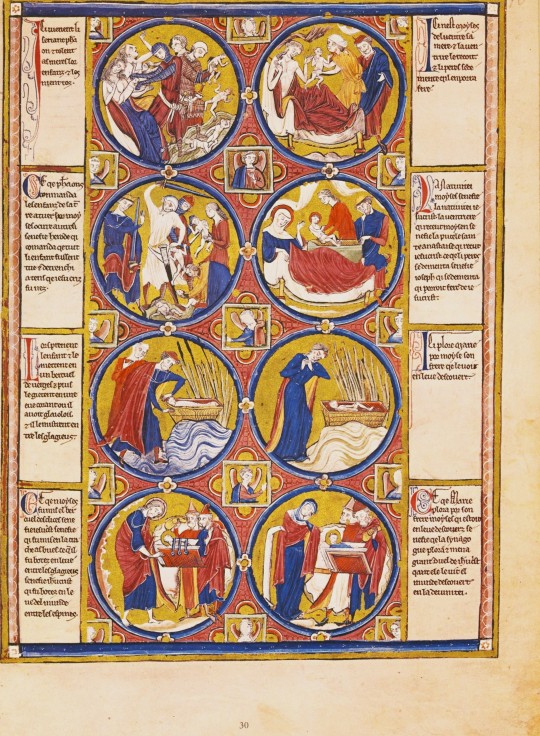
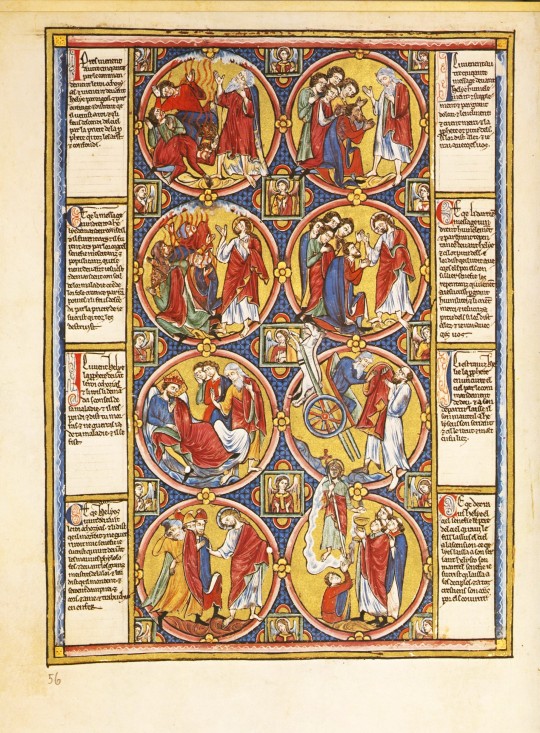
Interestingly, the designs on the pages of these bibles imitate stained glass representations at the time: the eight medallions placed in columns of four; the inclusion of quatrefoils in between these medallions; the use of vivid colors. This reflection of architectural design in the illuminations may have allowed people to visualize themselves in a church and may have led to more contemplative readings of the text that emphasized the teachings of priests and theologians at the time. One of the most well-known images in these types of bibles is Jesus as architect and creator of the universe. This type is seen on the frontispiece of this moralizing bible: Jesus is holding a compass as he focuses on the creation of the world. Geometry and astronomy were often associated with the divine in the Middle Ages and this viewpoint is well explained in Vanderbilt's Divinity Library website: "God has created the universe after geometric and harmonic principles, to seek these principles was therefore to seek and worship God."
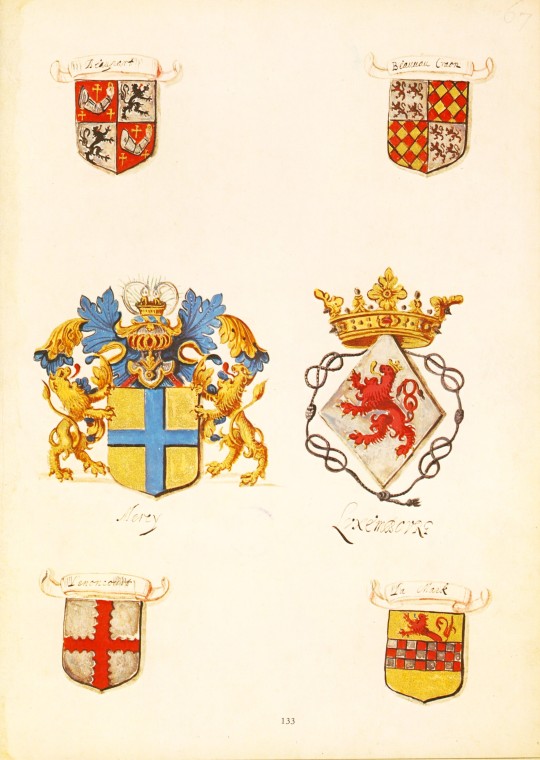
The creation of the moralizing bible also inspired later moralizing versions of books and poetry, like Ovid’s Metamorphoses. These types of moralizing volumes edited and changed parts of the works to make them conform to Christian teachings oft the time.
Our facsimile was published in 1973 by the Akademische Druck- u. Verlagsanstalt in Graz, Austria in an edition of 3,000 copies at the manuscript's original size. To see the original manuscript, you can visit the Österreichische Nationalbibliothek in Vienna or view the entirety of the manuscript online on their website here.
View more manuscript posts.
– Sarah S., Special Collections Graduate Intern
#Easter#bible moralisée#vienna bible moralisée#vienna 2554#austrian national library#Österreichische Nationalbibliothek#moralizing bible#bible#Akademische Druck- u. Verlagsanstalt#Christian bible#facsimiles#manuscripts#illuminated manuscripts#medieval manuscripts#Sarah S.#International Transgender Day of Visibility
50 notes
·
View notes
Text
Historical Misconceptions
I was inspired to write this after watching two minutes of a bad historian known as History Tea Time with Lindsay Holiday, not all examples are from her though
Joanna of Castile or otherwise known as Juana La Loca was NOT abused by Isabella of Castile with La Cuerda. Isabella certainly was a flawed mother, but there is no evidence to support that she was tortured by her. In fact, the notion she was tortured was written over 300 years after her death, and the source who wrote it under the pseudonym 'Bergenroth' pleaded guilty to academic fraud and it was later omitted from his paper. People tend to forget she was emotionally abused other than Physically Abused. Some may source Ferdinand of Aragon's claims against Phillip the Handsome's abuse towards her, but those were most likely fabricated to give Ferdinand more control of the Catalan Government.
Elizabeth I of England hated her father for beheading her mother (Anne Boleyn), lol what? Elizabeth was incredibly proud of being a Tudor and the daughter of the King of England. Yeah she wore the B necklace for Boleyn, but that doesn't mean Elizabeth hated her father. Henry didn't hate Elizabeth either, he surely didn't love her, but he did take somewhat of an active interest in her. The only daughter Henry hated was definitely Mary.
Elizabeth and Mary hated each other from day one. Not really. Mary loved children and helped raise Elizabeth from day one, even taking pity on her after Anne Boleyn's death. When Mary became Queen, she didn't really bother Elizabeth, nor did Phillip of Spain (Who also didn't hate Elizabeth at the time considering he didn't know Catherine of Aragon nor Anne Boleyn and wasn't exactly old enough to understand when the Kings Great Matter happened, he even saw Elizabeth as a marriage pawn for his cousin the Duke of Savoy). It only changed when Thomas Wyatt planned a Protestant Rebellion did Mary start to distrust Elizabeth, and in the end, Mary had the chance to kill her half-sister but chose not to.
Empress Matilda was a great leader. Definitely not. She was hated by most of England, and she relied on her teenage asshole husband to invade Normandy. Plus she was a foreigner in many respects as she had spent a considerable amount of time in Germany as the wife of Henry V of Germany. Part of England's dislike of her was sexism, but the other half was her being blatantly stupid, like her clusterfuck at Wallingford. Her sons must have inherited her stupidity due to their later actions in life (Especially her son Henry's). Say what you want about Stephen of Blois, but he at least knew what he was doing.
Mary, Queen of Scots was a victim. Reign stans are something else. Mary, Queen of Scots was even dumber than Empress Matilda and Edward III of England combined. To be fair, her mother Marie d'Guise was also a dumbass and thought it would be a good idea to marry her daughter to Francis of Valois (Who was probably impotent) to attempt to have France save their ass from Good Queen Bess, but then when Francis's ass died and France + England were starting to not want to waste resources on war with each other, Scotland was frankly left in the dust. Mary would inherit some of her mother's cardboard brain and decide to press claims on England, which makes literally no sense considering the Habsburg's are definitely not supporting her half-french ass even if she's Catholic, and France doesn't wanna fuck with England at the moment, she wasn't manipulated into doing any of this shit, she's no victim, she did this because she's stupid. Then after Scotland decides they had enough of her cardboard brain, they force her to abdicate and then she runs to England, the country she is laying claim on (wow so smart) and expects Elizabeth to give her shelter, which she does (Probably out of cousin loyalty, but damn, if another ginger who had previously called herself the Queen of my country suddenly trespassed on my clay, the only thing she'd be Queen of is the Cemetery when I'm done with her) and then even after Gloriana gives her a place to stay, Mary continues to wow us with her logic by recruiting an ugly teenager (Anthony Babington) to attempt to kill the Queen, and then Mary acts all shock when she finds out she cant just kill the person giving her space. After reign finished up, I was so happy Lizzie decided to kill that annoying ass bitch.
#history#scotland#empress matilda#anne boleyn#elizabeth i of england#joanna of castile#tudors#historical facts#fun facts
4 notes
·
View notes
Text
pride month for the gays, sad day yesterday for aragonese people:

via @/aragonesamonico stories on instagram
[Translation: On June 29th 1707, Phillip V, with the help of the Decretos de Nueva Planta, abolished the Fueros d'Aragón.
With this, the Kingdom of Aragon was lost, along with its laws and institutions, subjected from now on to the Kingdom of Castile.]
The Fueros were the laws of the Kingdom of Aragon. The first compilation of them is the Vidal Mayor, from the 12th century.
#i do nooottttt feel like making a thought out post abt this😭😭😭maybe next time#there was a manifestacion yesterday too i believe#anywaaaysssss fuck castilla i dont think it needs to be made obvious i hate castilla#polvo niebla viento y sol#aragón
7 notes
·
View notes
Text
crossover prompt?
So I was watching historical based videos about european royalty the other day and just thought -hey, what if medeival Europe just popped in house of the dragon/asoiaf world. Or what if certain historical characters did. Or what if The Catholics did. Or what if Isabella I of Castille replaced alicent hightower like that fics everyone likes making right now about a character replacing alicent's mind/body(?
I mean it would have to involve the idea of God or some deity existing and it's direct involve with Europe, the possibilitie of this royals accepting or seeking magic(?
Or how they would be rather good and faith politic warfare and stuff. Like the Catholics warfare was kind of based in the faith and that. Like the borgias were originally from Aragón.
Come on let's hear you out.
Extra point, just imagine the possibility of Joanna having Phillip eaten by a dragon.😜
#HotD#house of the dragon#alicent hightower#team green#team black#history#History thingy for the besties.#writing prompt#The catholics#royalty
3 notes
·
View notes
Text
NCIS INVESTIGATES A SHOOTOUT IN WHICH A RARE CULTURAL ARTIFACT IS STOLEN, ON “NCIS: LOS ANGELES,” SUNDAY, JAN. 8
“Blood Bank” – When NCIS investigates a shootout on a boat in which a rare cultural artifact is stolen, they’re shocked to learn who owns the boat, on the CBS Original series NCIS: LOS ANGELES, Sunday, Jan. 8 (9:30-10:30 PM, ET/9:00-10:00 PM, PT) on the CBS Television Network, and available to stream live and on demand on Paramount+*.
REGULAR CAST:
Chris O’Donnell
(Special Agent G. Callen)
LL COOL J
(Special Agent Sam Hanna)
Linda Hunt
(Operations Manager Henrietta “Hetty” Lange)
Daniela Ruah
(Special Agent Kensi Blye)
Eric Christian Olsen
(NCIS Investigator Marty Deeks)
Medalion Rahimi
(Special Agent Fatima Namazi)
Caleb Castille
(Special Agent Devin Rountree)
Gerald McRaney
(Retired Admiral Hollace Kilbride)
GUEST CAST:
Duncan Campbell
(NCIS Special Agent Castor)
Vyto Ruginis
(Arkady Kolcheck)
Kathleen Garrett
(Miraslava Borisova)
Dalia Rooni
(Riffat Murad)
Nikolay Moss
(Kostas Orlov)
Jonathan Kells Phillips
(Rupert Richardson)
Matty Cardarople
Emily Morales-Cabrera
(Danny)
(Assistant)
WRITTEN BY: Samantha Chasse
DIRECTED BY: Benny Boom
13 notes
·
View notes
Text
Today in History;
https://queencastile.wordpress.com/2022/10/20/today-in-history/
October 20th beheld the wedding of Joanna of Castile and Phillip Hapsburg, Duke of Burgundy. It was a splendid and spectacularly unhappy union which ended with Phillip’s early death and the usurping of Joanna’s rightful place as Queen Regnant of Castile.

3 notes
·
View notes
Text
Juana of Castile
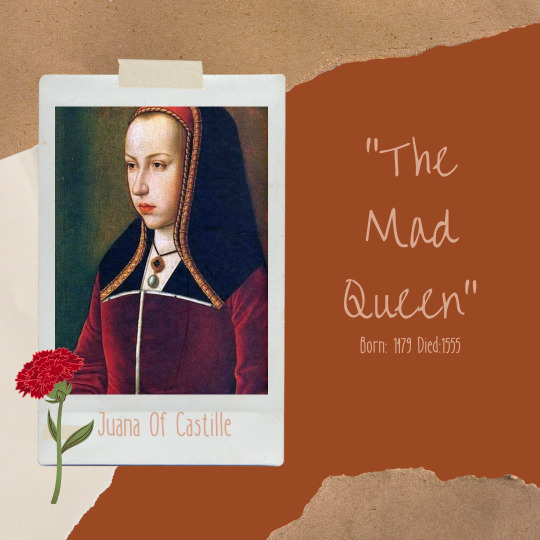
Sometimes known as Juana la Loca, Juana of Castile was the queen of Castile in modern-day Spain. It is said that she slashed the face of one of her husband's mistresses. When her husband died months later the story goes that she kept his coffin nearby for weeks so that she could kiss and embrace him. It is likely that these stories were made up or exaggerated by the men in Juana’s life to undermine her rule and prop up their own claims for the throne.
She was born the third daughter to power couple King Fernando II of Aragon and Queen Isabel I of Castile. The couple was deeply Catholic and when the teenage Juana voiced skepticism about their faith her mother had her tortured. After the death of her two older siblings, Juana became the heir to both the kingdoms of Aragon and Castile. King Phillip of Flanders Juana’s husband began using Juana for his own political agenda and later when Queen Isabel died and Juana became Queen of Castile she was under pressure by both her husband and father to give them her throne but she resisted. After the death of King Phillip from typhoid fever, Juana ruled Castile alone. Plagues and bad harvests affected Castile that year and it was unfairly blamed on Juana. She signed over her rule to her father King Fernando. He in turn locked Juana away in a convent, where she would spend the rest of her days. No one came to Juana’s rescue. Not even her own son Charles when he started his own reign after the death of King Fernando. All of Juana’s children became royalty across Europe and none of them ever freed their mother. In isolation, her mental illness worsened in the end she stopped allowing the nuns to take care of her. She died at 76 years old after 45 years of imprisonment. It is clear that no one in Juana’s life valued her. For the men in her life, she was just something in the way of their power. I wonder what her life would have been like if she’d been a man. Likely, it would have been quite different.
#history#world history#light academia#academia#humanities#mental illness#dark acamedia#dark acadamia aesthetic#queensofeurope#womeninshistory#european history#reading#studying
2 notes
·
View notes
Text
History Tuesday: Was “Joanna the mad” actually mad?
Juana of Castile, or also known as “Joanna the mad” or “Juana La Loca” was queen of Castile and Aragon from 1504 and 1516 respectively until her death in 1555, despite having two older siblings. She also had two younger sisters, one being Catherine of Aragon- former wife of King Henry VIII and Queen of England.
When she was just 16 in 1496, she was married to Philip the Handsome- the two going on to have 6 children together. She herself was an exceptionally smart young woman, being able to speak multiple languages such as French and latin, and was educated in a number of topics including math, philosophy, law, hunting, falconry, genealogy and music.
But unfortunately, she wasn’t given the nickname for her smarts. Sadly it was around 1504 when she was 24 years old she began to show signs of behavior issues and mental troubles. Her mother- Isabella of Castile would fall ill, leading to Juana choosing to not eat or even sleep. She would also become enraged when she was not allowed to travel to her husband fas she was dependent on him for comfort- due to a war. Later, in 1506 when her husband died, she would become incredibly irate. Its said when he was alive she was extremely jealous, and even once attacked a mistress with a pair of scissors. She would go as far as to not part with his corpse, often opening the coffin to speak to him and kiss him, even possibly lying with the body prior to his burial. At this time, she had lost her mother and husband, as well as her two older siblings and nephew. And, to top it off- she was heavily pregnant, could it been the hormones?
Historians believe the possible mental instability could be traced back to her maternal grandmother, being so ill she was sent to a convent. Juana possibly suffered from depression (even post-partum) schizophrenia, and psychosis, but its also speculated her illnesses would be extremely dramatized by those closest to her.
When her mother passed, this made her Queen of Castile. Though, Isabella would tell her husband and father to Joanna- Ferdinand II of Aragon before her passing that he could take over reign only if Joanna was deemed “unfit” to rule. To which he would try to take that from her. He would even try to conspire with Phillip though he died soon after. When her father returned to Castile in 1507 he managed to force Joanna to revoke her royal powers over Hornillos.
Even prior to Philips death he himself would spread rumors of her mental instability, which was believed even when her son- Charles became the holy roman emperor. He would have her committed to the Convent of Santa Clara in Tordesillas, and refuse her any visitors. This is where she remained until her death in 1555 at age 75.
Sources: The Madness of Juana of Castile, Queen Juana: The mad or the betrayed?, Who is Joanna the Mad?, Juana of Castile and Her Madness, Joanna of Castile: A Misunderstood Queen in Portraits
0 notes
Text

Juana I of Castille before the tomb of her husband, Phillip the Handsome, bueno Francisco Pradilla y Ortíz.
0 notes
Text
Question 5:
After September 11th 1714 the decrees of Nova Planta were proclaimed in Catalonia by Philip V. Mention
the main changes in catalan society doing a little research after the Field study.
After the Nova Planta Decrees were proclaimed in Catalonia by Phillip V, the Catalan constitutional system and institutions were abolished. This was done to submit the Catalans under the laws of Castile and for Philip V to establish absolutism over his domains. Overall, the Decrees were an attempt to put an end to the Crown of Aragon and transition it into the Crown of Castile under an absolute monarchy. Although Catalonia was supposed to be "integrated" into Spain, some say this caused the destruction of the Catalan nationality. Some effects of the Decrees include that Castilian became the sole language of the government, meaning court cases could only be presented in Castilian which displaced Latin and Catalan. On the other hand, it allowed Catalonia to have an industrial revival with a domestic market across Spain and an overseas market with the American colonies.
0 notes
Text
youtube
As we commemorate the legacy of Martin Luther King Jr. this weekend, I renew attention to David Byrne's American Utopia. The central idea is that the world depends on our individual, inner transformation of mind and heart, which we cannot accomplish alone. Our true selves are linked to one another through relationships.
Byrne covers Janelle Monae’s “Hell You Talmbout” to name African-American victims of American law enforcement and the systemic racism that continues to perpetuate this ongoing legal form of genocide.
Say their names.
Eric Garner, John Crawford III, Michael Brown, Ezell Ford, Dante Parker, Michelle Cusseaux, Laquan McDonald, George Mann, Tanisha Anderson, Akai Gurley, Tamir Rice, Rumain Brisbon, Jerame Reid, Matthew Ajibade, Frank Smart, Natasha McKenna, Tony Robinson, Anthony Hill, Mya Hall, Phillip White, Eric Harris, Walter Scott, William Chapman II, Alexia Christian, Brendon Glenn, Victor Manuel Larosa, Jonathan Sanders, Freddie Blue, Joseph Mann, Salvado Ellswood, Sandra Bland, Albert Joseph Davis, Darrius Stewart, Billy Ray Davis, Samuel Dubose, Michael Sabbie, Brian Keith Day, Christian Taylor, Troy Robinson, Asshams Pharoah Manley, Felix Kumi, Keith Harrison McLeod, Junior Prosper, Lamontez Jones, Paterson Brown, Dominic Hutchinson, Anthony Ashford, Alonzo Smith, Tyree Crawford, India Kager, La’vante Biggs, Michael Lee Marshall, Jamar Clark, Richard Perkins, Nathaniel Harris Pickett, Benni Lee Tignor, Miguel Espinal, Michael Noel, Kevin Matthews, Bettie Jones, Quintonio Legrier, Keith Childress Jr., Janet Wilson, Randy Nelson, Antronie Scott, Wendell Celestine, David Joseph, Calin Roquemore, Dyzhawn Perkins, Christopher Davis, Marco Loud, Peter Gaines, Torrey Robinson, Darius Robinson, Kevin Hicks, Mary Truxillo, Demarcus Semer, Willie Tillman, Terrill Thomas, Sylville Smith, Alton Sterling, Philando Castile, Terence Crutcher, Paul O’Neal, Alteria Woods, Jordan Edwards, Aaron Bailey, Ronell Foster, Stephon Clark, Antwon Rose II, Botham Jean, Pamela Turner, Dominique Clayton, Atatiana Jefferson, Christopher Whitfield, Christopher Mccorvey, Eric Reason, Michael Lorenzo Dean, Breonna Taylor.
This non-comprehensive list of Black people in the United States killed by police since July 2014 was compiled by National Public Radio’s Code Switch as part of an episode entitled “A Decade of Watching Black People Die.”
#racism#social justice#conservatism#David Byrne#american utopia#black lives matter#BLM#genocide#defund the police#Martin Luther King Jr.#mlkday#activism#music#hope#H2shO™️#discrimination#water aerobics#hell you talmbout#janelle monáe robinson#Youtube
0 notes
Photo

Pilar Lopez de Ayala as Juana of Castile, and Daniel Liotti as Phillp of Hapsburg and Castile, in “Mad Love.”(Juana la Loca.).
#movies#mad love#juana la loca#juana of castile#joanna the mad#pilar lopez de ayala#phillip of hapsburg#phillip of castile#phillip the handsome#daniel liotti#tudor era#early modern#renaissance#spain#spanish history#europe#16th century#historical#period dramas
4 notes
·
View notes
Text

Phillip the Handsome, Archduke of Austria and his sister Margaret. From the Spanish TV series "Isabel". Definitely worth a watch if you like late 15th and early 16th Century history. The 3 seasons were followed by "La Corona Partida" (the broken crown) which tells the story of Juana of Castile and then finally Carlos Rey Emperador, the story of the emperor Charles V 👑👑
#isabel#la corona partida#carlos rey emperador#isabella of castile#ferdinand of aragon#ferdinand and isabella#archduke and archduchess#archduke phillip#archduchess margaret#juana of castile#juana the mad#charles v
16 notes
·
View notes
Text

11 notes
·
View notes
Photo

Tell Me A Story - Season 2 + Opening Credits
GALLERY LINK : [x]
Quality : HD Screencaptures
Amount : 10799 files
Resolution : 1280x561px
-Please like/reblog if taking!
-Please credit grande_caps/kissthemgoodbye!
#tell me a story#tmasedit#kathryn prescott#phillip rhys#casey thomas brown#evan parke#garcelle beauvais#caleb castille#christopher meyer#harry shum jr#julia campbell#felisha terrell#matt walton#karina logue#capped by randomkiwibirds
8 notes
·
View notes
Text
Day of Aragonese Rights and Liberties
December 20th marks the anniversary of the beheading of Juan de Lanuza V by the government of Phillip II (I of Aragon) in 1591.
It all started with the unification of the kingdoms of Castile and Aragon, and the transfer of most government functions to Castile, which caused a lot of dissatisfaction within Aragon. On top of this, Antonio Pérez, the secretary of state for the king, had betrayed the king and planned behind his back. This caused the king to order his torture and to be judged by the Inquisition. Antonio, having Aragonese ancestry, seeks refuge in Aragon, since with our own fueros (laws), the kingdom functioned differently than Castile.
He was protected by the derecho de Manifestación, which granted him a fair trial, and protection under the Justice of Aragon. At the time, this position was occupied by Juan de Lanuza "el Mozo". Under Aragonese law, Antonio Pérez was free, since he had commited no crimes in Aragon. Even with these laws, the Inquisition requested for Antonio.
The city of Zaragoza rose against this order, but the king ordered the entry to the city. This was considered contrafuero (illegal) in the eyes of the Justice, which officially declared confrontation of the government of Aragon against the king. This confrontation ended with the Castilian forces occupying Zaragoza and the entire kingdom.
Within all this confrontation, Juan de Lanuza had escaped from Zaragoza to Épila, and Antonio Pérez escaped to France. After the taking of Zaragoza, Juan returns to Zaragoza in November of 1591, and on December 19th, he is arrested, and beheaded without trial the next morning.

From this, every year on December 20th in Aragon we celebrate the day of Aragonese Rights and Liberties, and Day of the Justice of Aragon. We commemorate the execution of Juan de Lanuza, and mourn the loss of our own laws, the Fueros de Aragón, in 1707, with the New Plant Decree.


Left: commemorative statue to Juan de Lanuza, by Félix Navarro (1904), made all with Aragonese materials. Right: Plaque on the Central Market, where Juan de Lanuza was beheaded, for the 400 year anniversary of his death.
As our own fueros said, antes leyes que reyes.
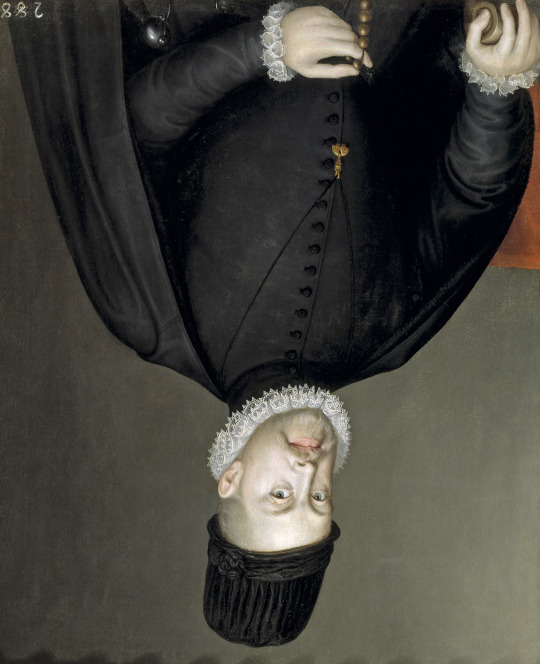
#now i hope yall understand exactly why we have ONE single statue in the entirety of aragon for felipe#and this isnt even the whole story bc there was a whole ass rebellion that yr and this was just the ending#and why theres a statue of juan de lanuza my beloved <3 in the plaza aragón <3#also no its not only you. everytime i see this statue at first glance i think he's doing the n*zi salute dont worry#juan de lanuza#felipe ii#revuelta de aragón#reino de aragón#polvo niebla viento y sol
21 notes
·
View notes